
Author Regina Robinson explores a new topic each month in her "Did You Know?" series, which comes out in the Olympia Branch Newsletter.
Long before Washington State's Mount St. Helens famously erupted in 1980, the mountain was a defining feature in the landscape Native American tribes called home. Check out the legend of Mount St. Helens and check out some tips for planning your trip to this beautiful area.
Native American Legend of Mount St. Helens
Before Mount St. Helens blew its top, it was a beautifully symmetric rounded snow-capped mountain that stood between two powerfully jagged peaks Mt. Hood (which Native Americans called Wy'east) and Mt. Adams (which Native Americans called Klickitat). According to one Native American legend, the mountain was once a beautiful maiden, "Loowit." When two sons of the Great Spirit "Sahale" fell in love with her, she could not choose between them. The two braves, Wyeast and Klickitat fought over her, burying villages and forests in the process.
Sahale was furious. He smote the three lovers and erected a mighty mountain peak where each fell. Because Loowit was beautiful, her mountain (Mount St. Helens) was a beautiful, symmetrical cone of dazzling white. Wyeast (Mount Hood) lifts his head in pride, but Klickitat (Mount Adams) wept to see the beautiful maiden wrapped in snow, so he bends his head as he gazes on St. Helens. This is one of many Native American legends involving Mount St. Helens.

Travel Tips
Mount St. Helens is located in Washington State off I-5 approximately 2.5 hours south of Seattle and 1.5 hours north of Portland. More than 500,000 visitors visit it each year. The majority of the visitors enter from Highway 504 on the west side, which offers two main visitor centers: Johnston Ridge Observatory ($8/adult) at milepost 52, and the Forest Learning Center (Free) at milepost 33. Travelers from Seattle should take exit 63 through Toledo and those from Portland can take exit 49, Castle Rock.
Mount St. Helens has a secondary viewing area at Windy Ridge accessed from the north side of the park off Highway 12 near Randle via highway 25 / 99. Lacking any amenities, this is a winding road with steep drop offs though the views are quite scenic.
You can view the mountain online through the Mount St. Helen's Volcano Cam.
 Regina Robinson
Regina Robinson